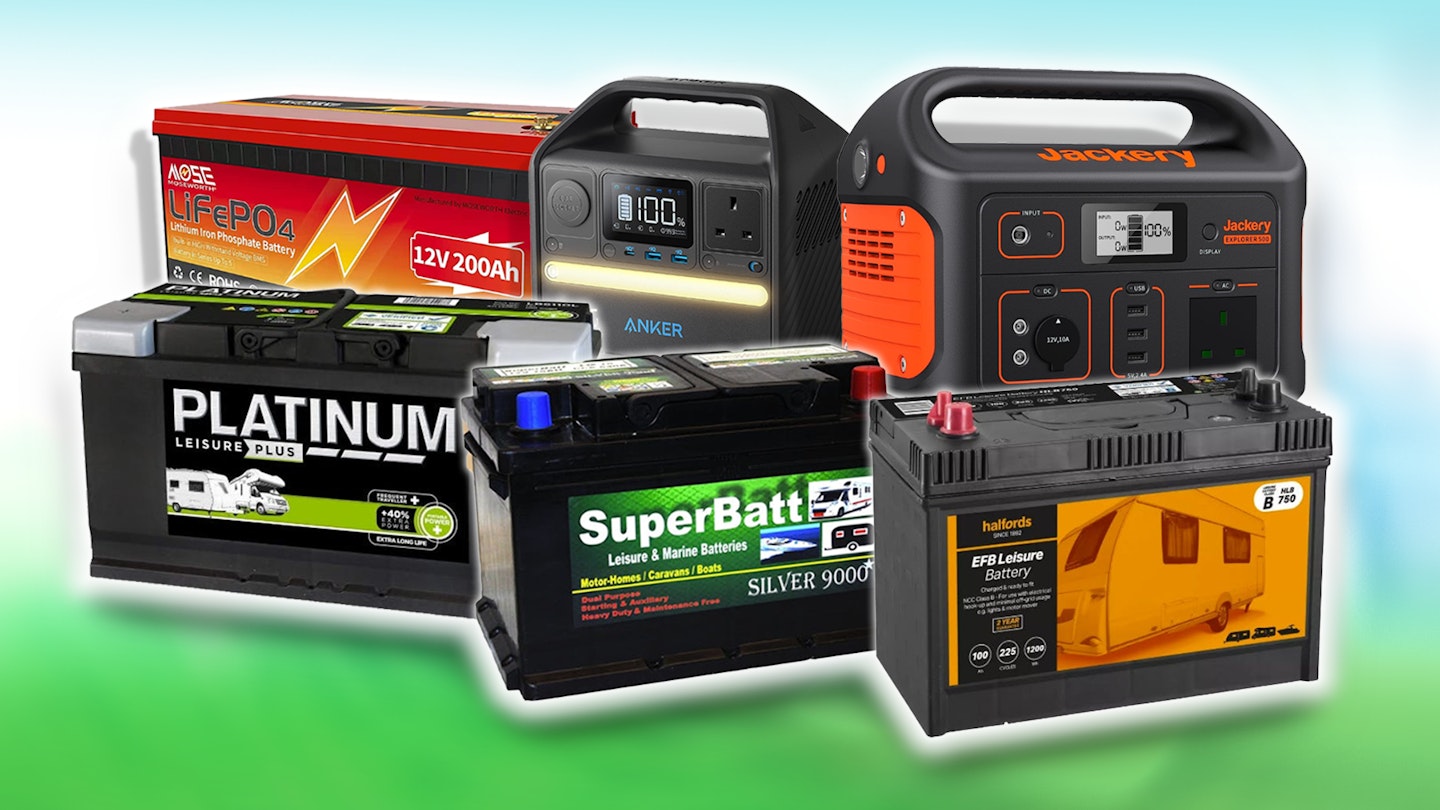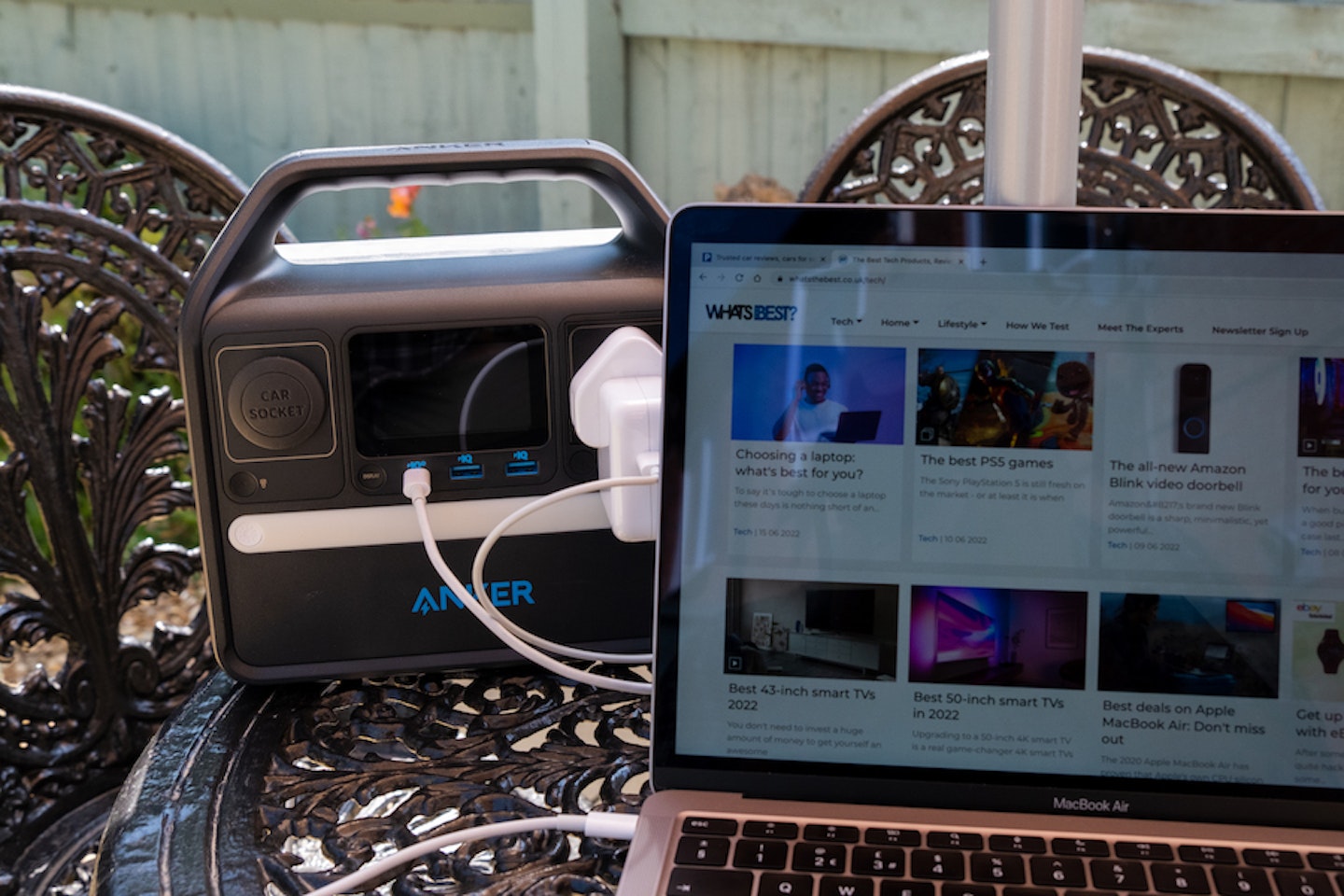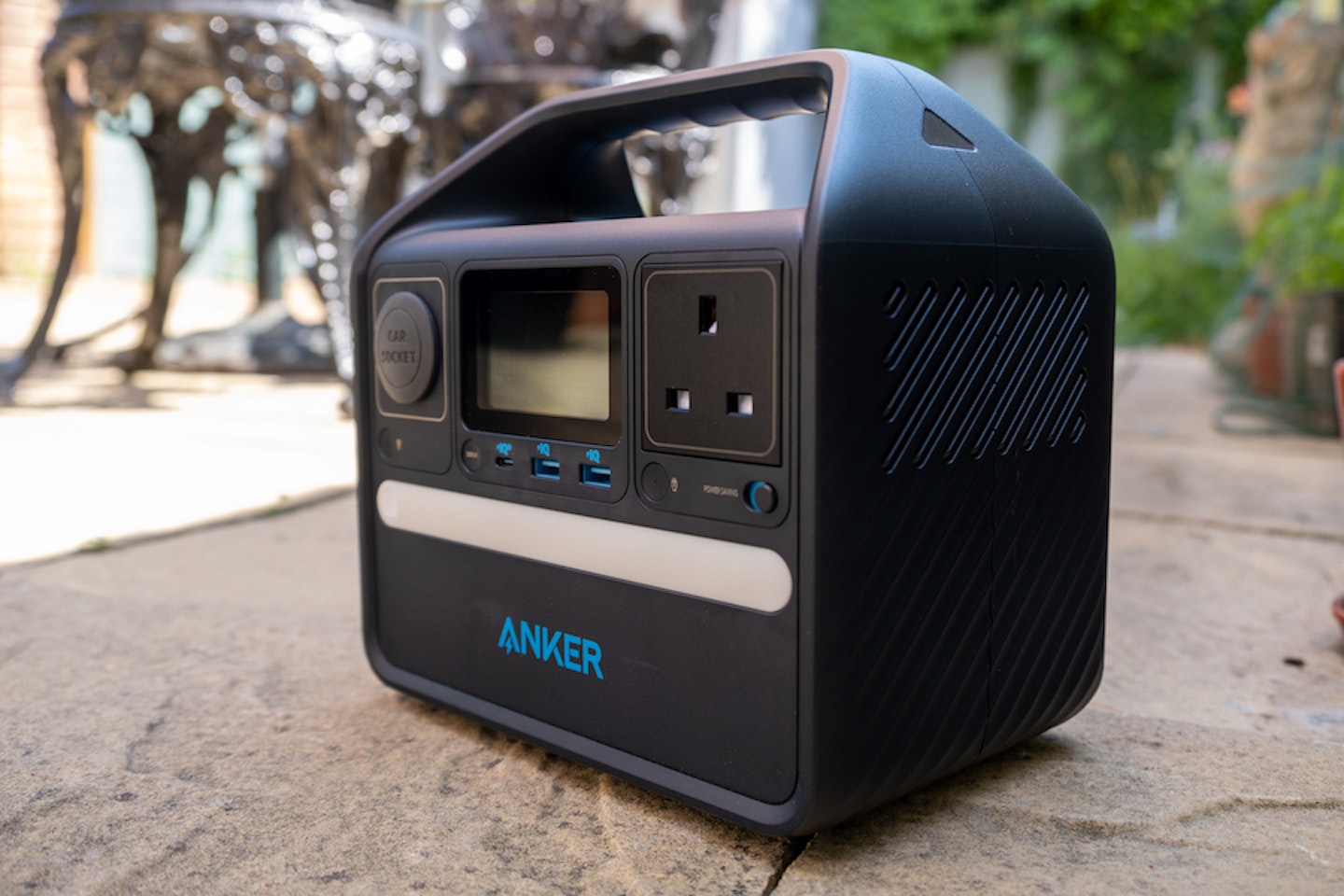There's not much point in packing your electric bike, TV or electric heater into your caravan, motorhome or marine vehicle if you don't have one of the best leisure batteries. Unlike those found in regular cars, they provide a steady flow of electricity for longer – able to power your essential equipment while out and about.
These compact power packs run necessities like pumps, fans and lights; but also domestic comforts, such as compact 24-inch TVs, portable heaters and microwaves. Yes, they're essential when leaving home for a break in your vehicle – but having the best leisure batteries at home can also come in handy in a power cut if you have portable equipment handy.
Whether you’re new to portable power, or a seasoned user looking for the best leisure batteries to replace any old ones, you'll need some facts at hand. Assessing your requirements can be tricky, especially if you have a large collection of camping gadgets to plug in. Knowing how to use a leisure battery is essential. There are three classes to choose from – A, B and C – with A being the highest capacity for longer off-grid trips. We've put together a buyer’s guide at the end of the article, breaking down other key features and answering common questions.
The best leisure batteries of 2025 at a glance:
• Best overall: SuperBatt AGM1100 12V 120Ah VRLA – View at Amazon
• Best budget: SuperBatt LM75 Deep Cycle Leisure Battery – View at Amazon
• Best Class A: Platinum AGM AGMLB6110L 100Ah – View at Amazon
• Best Class B: Halfords HLB750 100Ah – View at Halfords
Here are a selection of the best options on the market, with useful categories to help you choose. So, grab your camping fridges and pack some clothes – we're going to get you powered up for your next big trip.
All prices are correct at the time of writing. Prices, stock and deals are subject to change without notice.
Best leisure batteries of 2025
Best overall
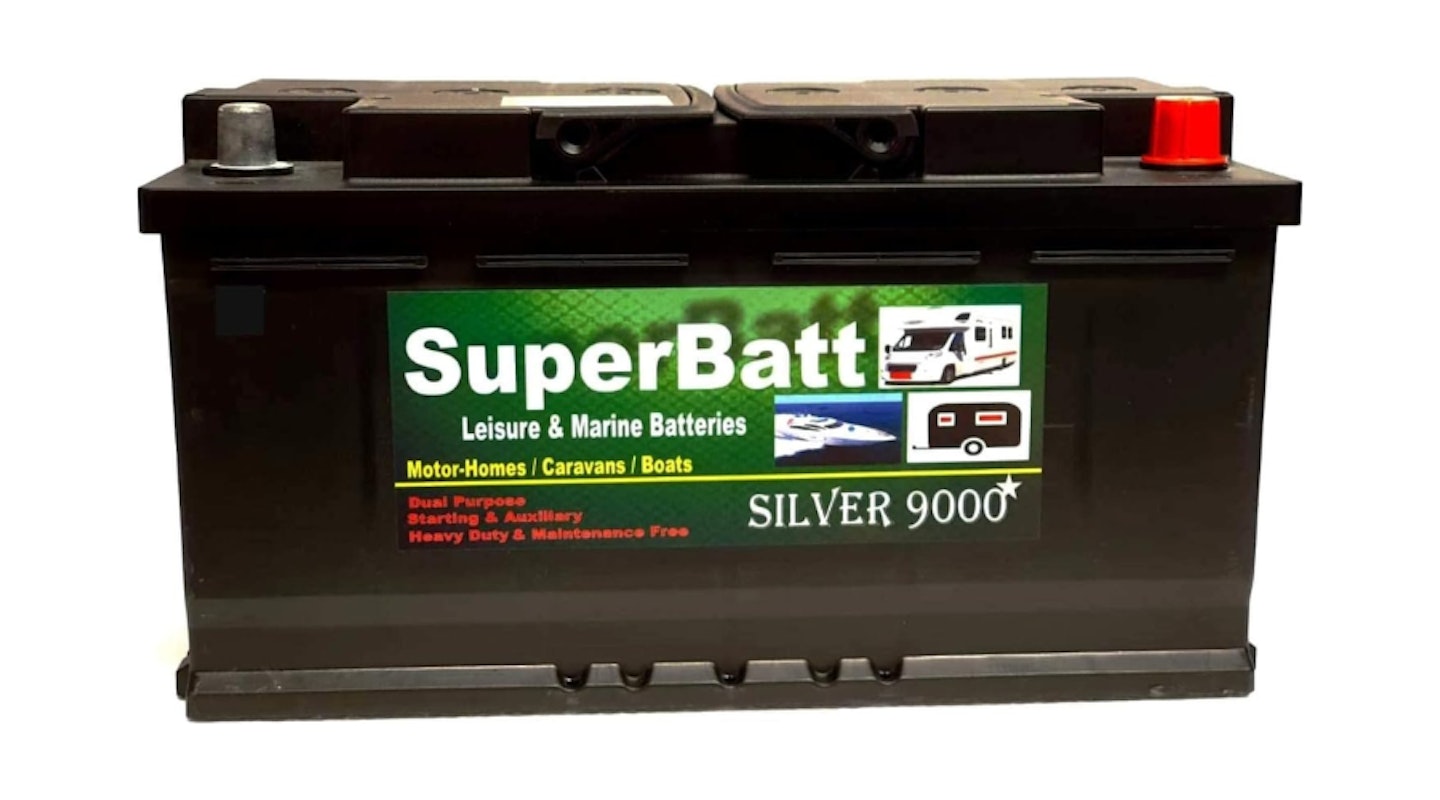 Amazon/SuperBatt
Amazon/SuperBattIf you're planning on a proper road trip, you'll need a great supply of power. The SuperBatt AGM1100 is a serious leisure battery packing 120 amp-hours of power. That's enough to supply all your essentials and heavy-duty appliances at once for longer trips away from mains hookup. But, the key feature at the top of our list is that it's been designed to deliver that power in a stable and consistent fashion between deep cycles. That means that you can charge this up and use it right to the end before recharging. This excellent battery technology delivers three to four times more cycles than a standard leisure battery as well.
Pros
- Spill-proof and sealed
- Great for long journeys
- Perfect for heavy-duty appliances
Cons
- Larger than others due to the capacity so make sure you have room
| Capacity | 120 Ah |
| Dimensions | 175D x 354W x 190H mm |
| Battery technology | AGM |
| Battery Class | Class A |
| Terminal | Marine |
| Voltage | 12V |
| Weight | 27kg |
Best budget
 Amazon/SuperBatt
Amazon/SuperBattWe think that SuperBatt's 75Ah class A leisure battery is perfect for day or long weekend trips, giving you plenty of power for your home comforts and appliances when you're not on a mains hookup. It's probably not enough for larger vehicles with lots of gadgets, but for the essentials, it's all you need for that short trip away.
Pros
- Very affordable for smaller vehicles or light occasional use
- Suitable for various vehicles, from caravans and motorhomes to boats
- Small and practical to move and fit
Cons
- Maybe a little under the stated 75Ah
| Capacity | 75Ah |
| Dimensions | 278D x 175W x 175H mm |
| Battery technology | Wet Cell Flooded Lead Acid Battery |
| Battery Class | C |
| Terminal | Marine |
| Voltage | 12V |
| Weight | 16kg |
Best Class A
 Amazon/Platinum
Amazon/PlatinumThe Platinum AGMLB6110L is a 100Ah battery and, in our opinion, one of the best Class A AGM batteries around. AGM is the glass matting inside that is more efficient at holding and retaining charge. That means you can leave it in your vehicle for longer periods without maintenance. It is a highly reliable Class A battery meaning it can be used extensively off-grid for heavy-duty use with motors, plus microwaves, kettles and TVs.
Pros
- Great capacity for a Class A battery
- Perfect for running high-power items
- Good for motor movers
Cons
- Heavy, so depending on the vehicle you may need a second pair of hands to fit
| Capacity | 100Ah |
| Dimensions | 354D x 175W x 190H mm |
| Battery technology | AGM |
| Battery Class | Class A |
| Terminal | Marine |
| Voltage | 12V |
| Weight | 25.9kg |
Best Class B leisure battery
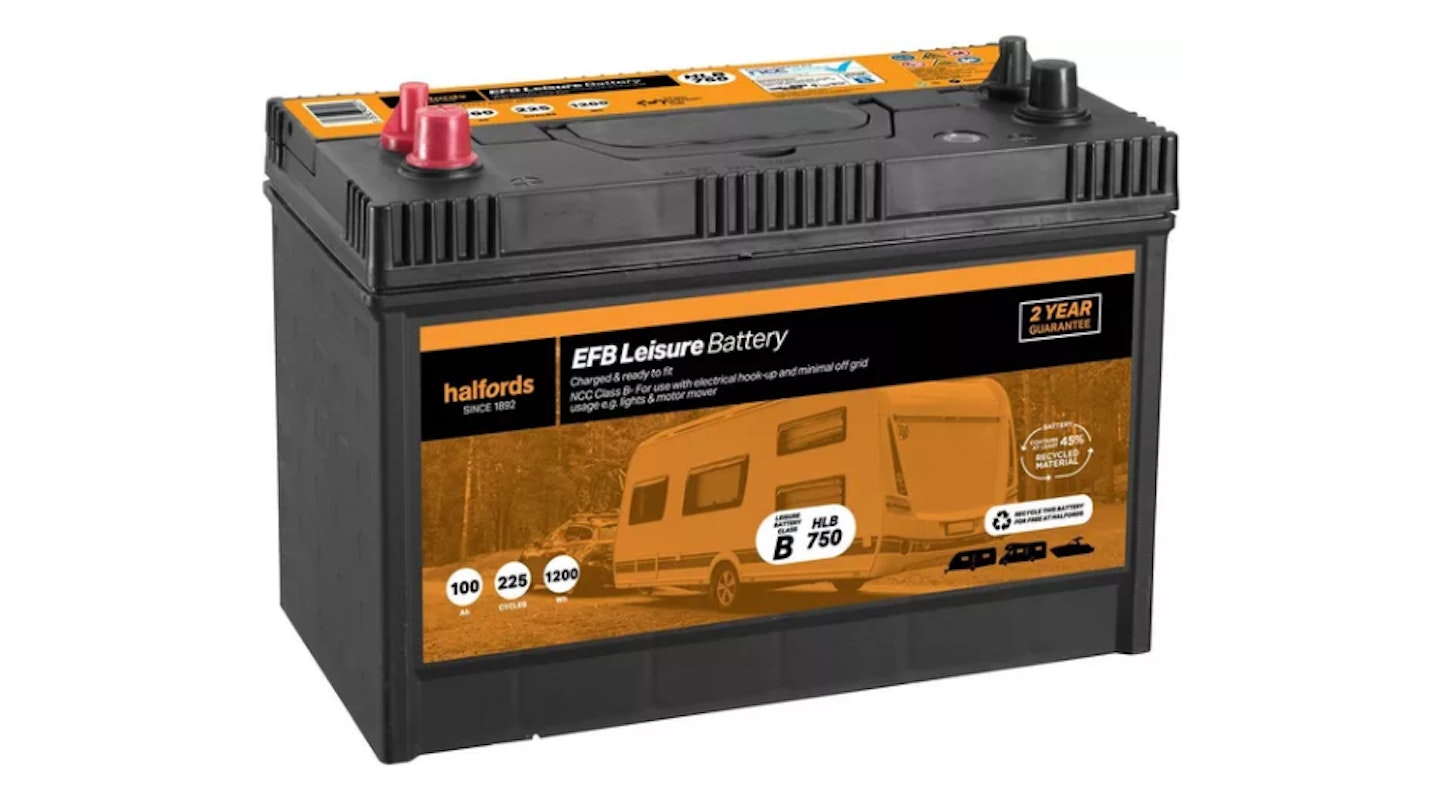 Halfords
HalfordsThe Halfords HLB681 has 100Ah and weighs 26kg – that's a decent amount of power for a relatively compact unit. This is a Class B leisure battery, meaning that it has to be used with an electrical hookup where possible, but can also be used to power a limited number of higher-power devices like motor movers. It has a manufacturer's guarantee of two years for extra peace of mind. If you need Class B power we think this one is hard to beat.
Pros
- Class B performance for some high-power devices
- EFB technology for faster charging
- Dual terminals for attaching extra devices with ease
Cons
- May need topping up from new
| Capacity | 100Ah |
| Dimensions | 330D x 173W x240H mm |
| Battery technology | EFB |
| Battery Class | B |
| Terminal | Marine |
| Voltage | 12V |
| Weight | 26Kg |
Best power station
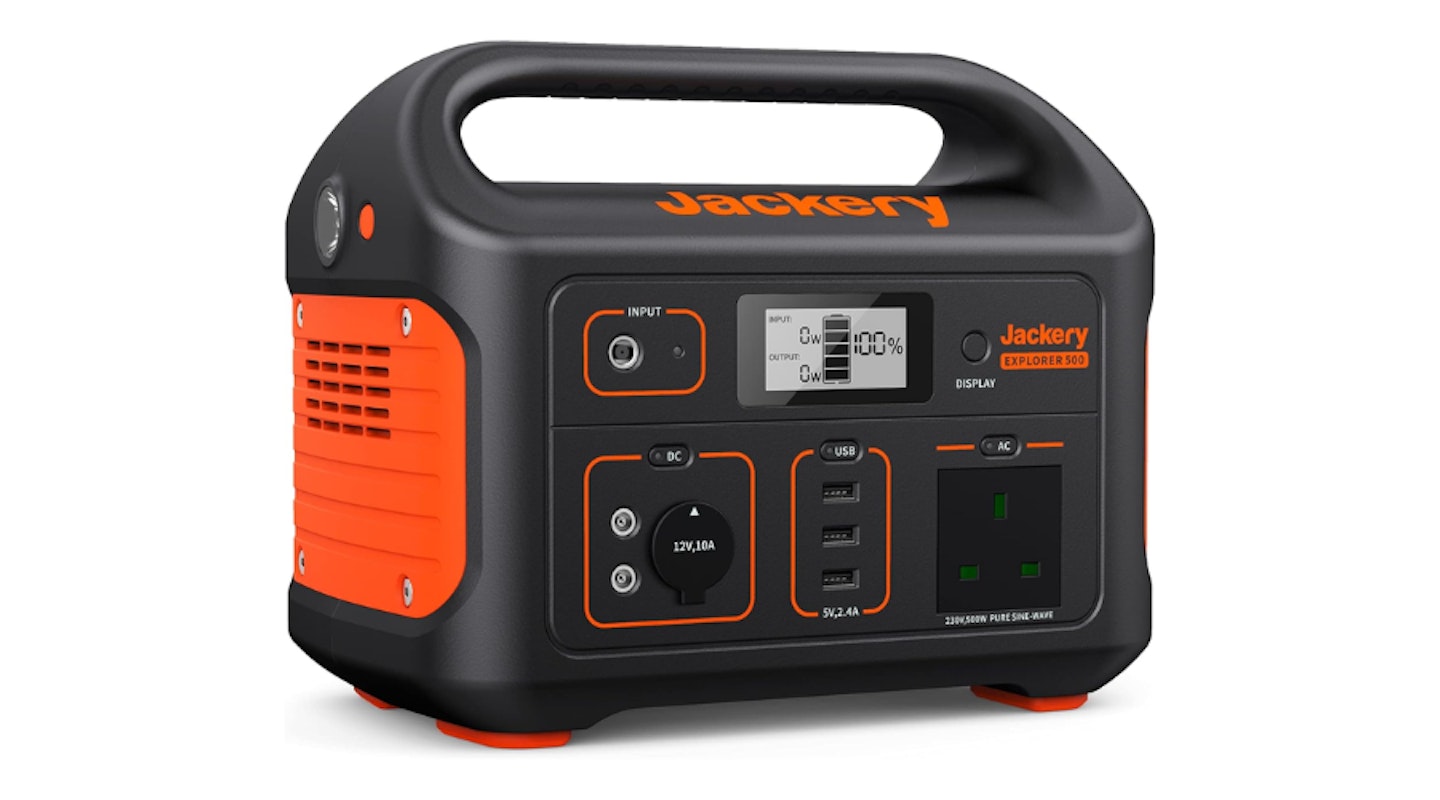 Amazon/Jackery
Amazon/Jackery This Jackery Portable Power Station Explorer 500 is a very compact powerhouse that is versatile and practical. Not everyone wants the hassle of setting up a normal leisure battery, so this is ideal for those who want extra power wherever they go in a convenient package. A three-pin socket, 2V/10A carports and three USB ports really make this a fantastic solution as a portable gadget power station as well as an auxiliary leisure battery.
We had What's The Best contributor Adam Binnie test and review the Jackery Explorer 500, and he had this to say – "A mobile power station like the Jackery Explorer 500 is likely to be one of those things you either overlook entirely or immediately dream up a thousand uses for. If you’re in the latter group, then you won’t go far wrong with this one - it's great for everything from providing power to an outside office to recharging camera batteries on an assignment, and it's particularly useful when teamed with a Jackery solar panel for the ultimate summer camping set-up."
Pros
- Robust construction with well-designed and placed carry handle
- Doesn't need an inverter for mains power
- Short circuit protection
Cons
- 500w limit so definitely do your power usage maths
| Capacity | 518Wh (24Ah, 21.6V) |
| Dimensions | 354 x 175 x 190 mm |
| Battery technology | Lithium |
| Battery Class | n/a |
| Terminal | 3 x USB-A port. Car Port: DC 12V, 10A |
| Voltage | 230V |
| Weight | 6kg |
This Anker 521 PowerHouse is the ultimate in having lots of recharging power in a small package. It really is the right size for picking up and ambling down to the end of the garden, the beach, or anywhere you might need to work or enjoy your favourite gadgets. Invest in a solar panel and you can recharge it anywhere. This is a leisure battery in more ways than one.
What's The Best's Editor, William Austin-Lobley, has reviewed the Anker 521 – "I'm very taken with the Anker 521 Portable Power Station. It fulfils its brief in full, delivering great amounts of recharging power in a very portable package.
"While there are a few downsides to the device (car socket, lack of solar panel, only one USB-C) in practice, the Anker 521 operates without fault. It provides welcome flexibility when camping, working with laptops and cameras in a remote location, or just soaking up rays at the end of their garden."
Pros
- Great capacity and portable
- Power Saving function
- USB-C charging
Cons
- Only one USB socket is a little limiting
| Capacity: | 12.8V/20000mAh 256Wh |
| Dimensions | 216D x 144W x 212H mm |
| Battery technology | Lithium |
| Battery Class | n/a |
| Terminal | USB-A port. USB-C port. Car Port: DC 12V, 10A |
| Voltage | 230V (A/C) |
| Weight | 3.7kg |
Best high-capacity
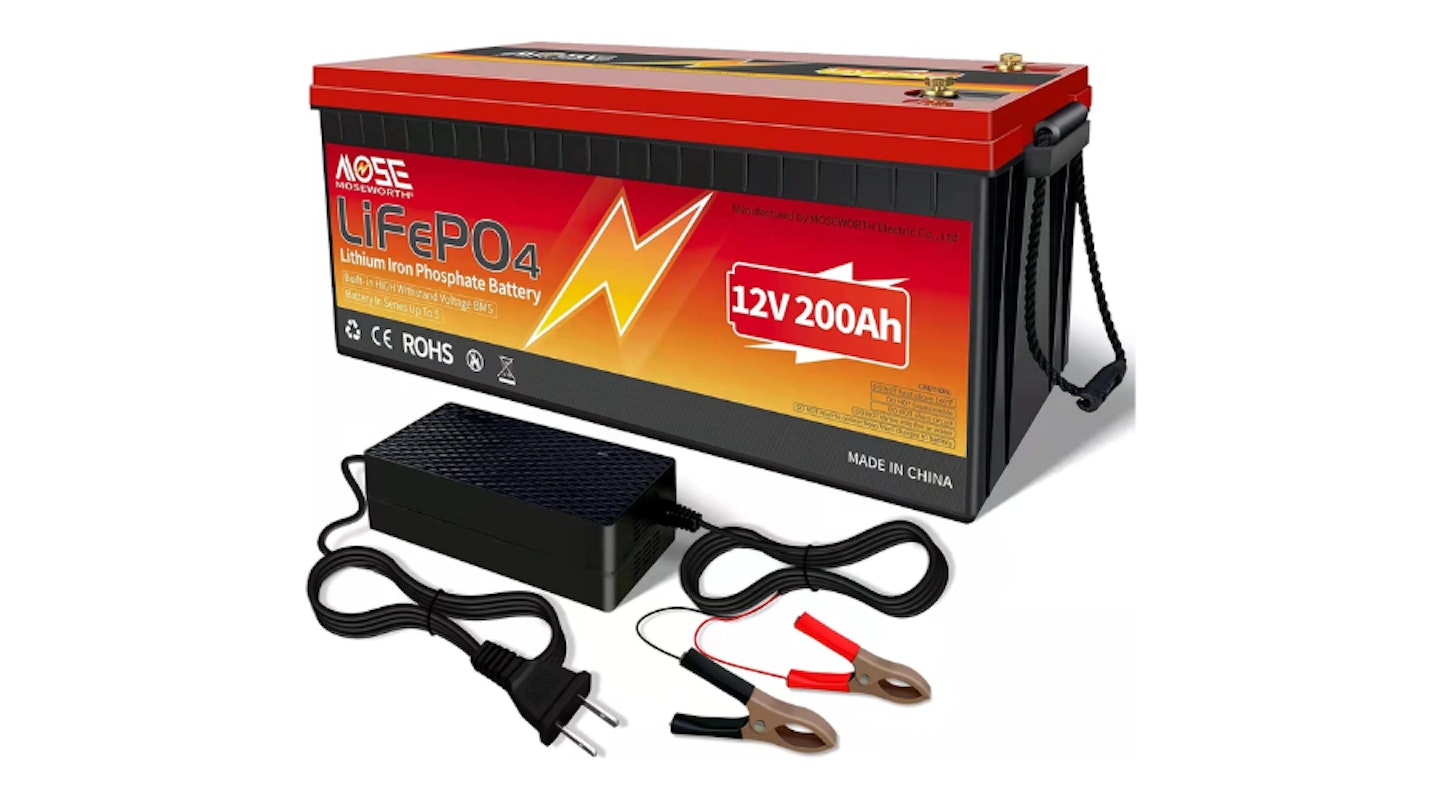 Amazon/MOSEWORTH
Amazon/MOSEWORTH This Lifepo4 battery from MOSEWORTH has a huge 200Ah capacity. We love the fact that it can be connected in series or parallel for even more power and an efficient setup. It's a lithium battery and therefore requires no maintenance. There's a 2-year warranty too, plus short-circuit or high-temperature cut-off protection for even more peace of mind.
Pros
- Smaller and longer lifespan than other technologies
- Good energy density for less weight
- Various types of cut-off protection
Cons
- User manual is not the clearest
| Capacity | 200Ah |
| Dimensions | 525D x 240W x 218H mm |
| Battery technology | Lithium Iron Phosphate(LiFePO4) |
| Battery Class | n/a |
| Terminal | M8 |
| Voltage | 12V |
| Weight | 21kg |
Best for solar panel charging
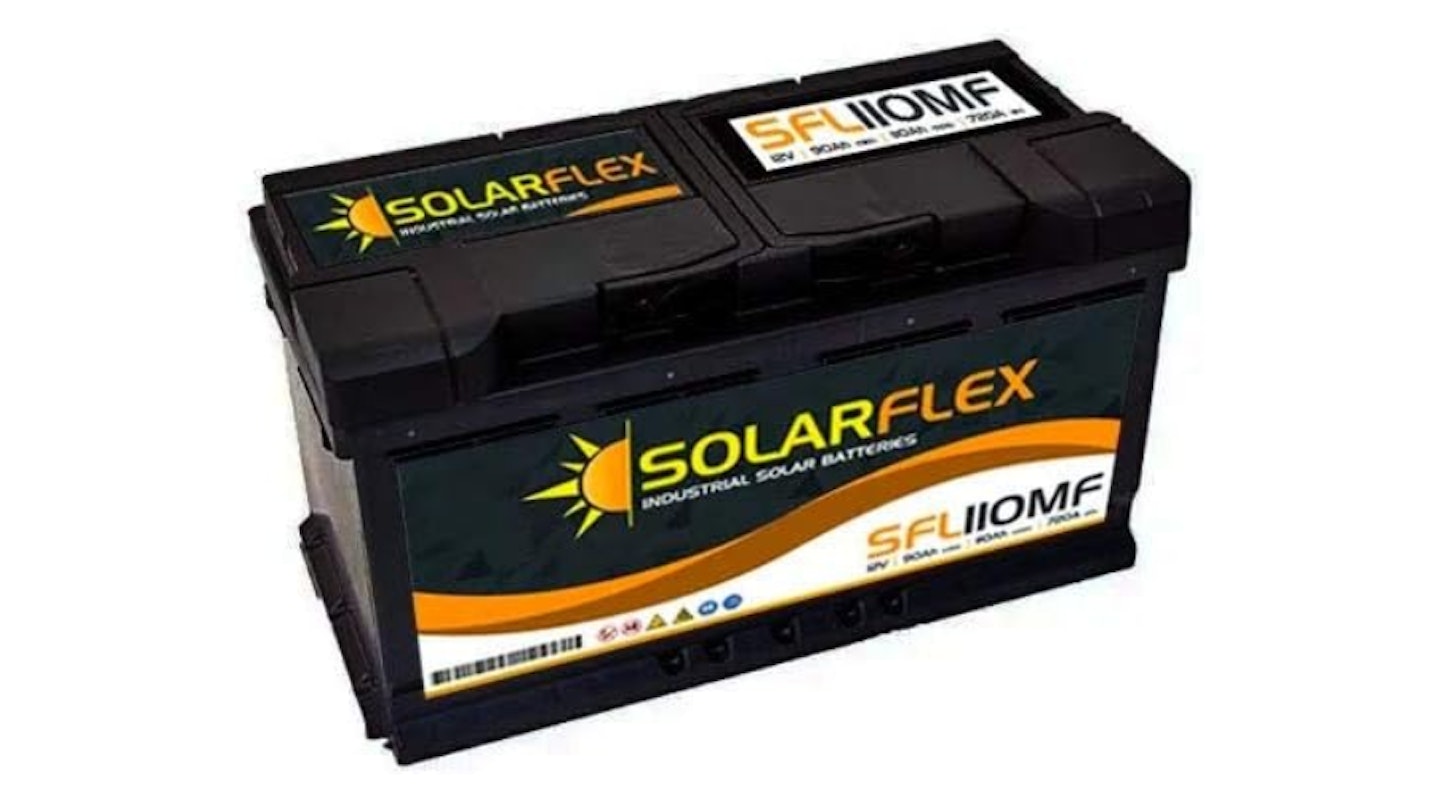 Amazon/Solarflex
Amazon/Solarflex For those in need of a great solar leisure battery, you need a Solarflex industrial battery. This solar-powered leisure battery is perfect for an off-grid motorhome adventure. The obvious benefit here is being able to recharge it for free, giving you a cost-effective and reassuring power source when you need it. We also love that it's been designed to support dumping large amounts of charge back into the grid for those running grid-assist solar storage banks.
Pros
- Excellent for solar power panel hookup
- Great capacity for a solar system
- Also tops up via a compatible alternator
Cons
- May need more maintenance to retain its charging capacity
| Capacity | 110Ah |
| Dimensions | 353D x 175W x 190H mm |
| Battery technology | Wet |
| Battery Class | Not specified |
| Terminal | Marine |
| Voltage | 12V |
| Weight | Not specified |
Best Class C
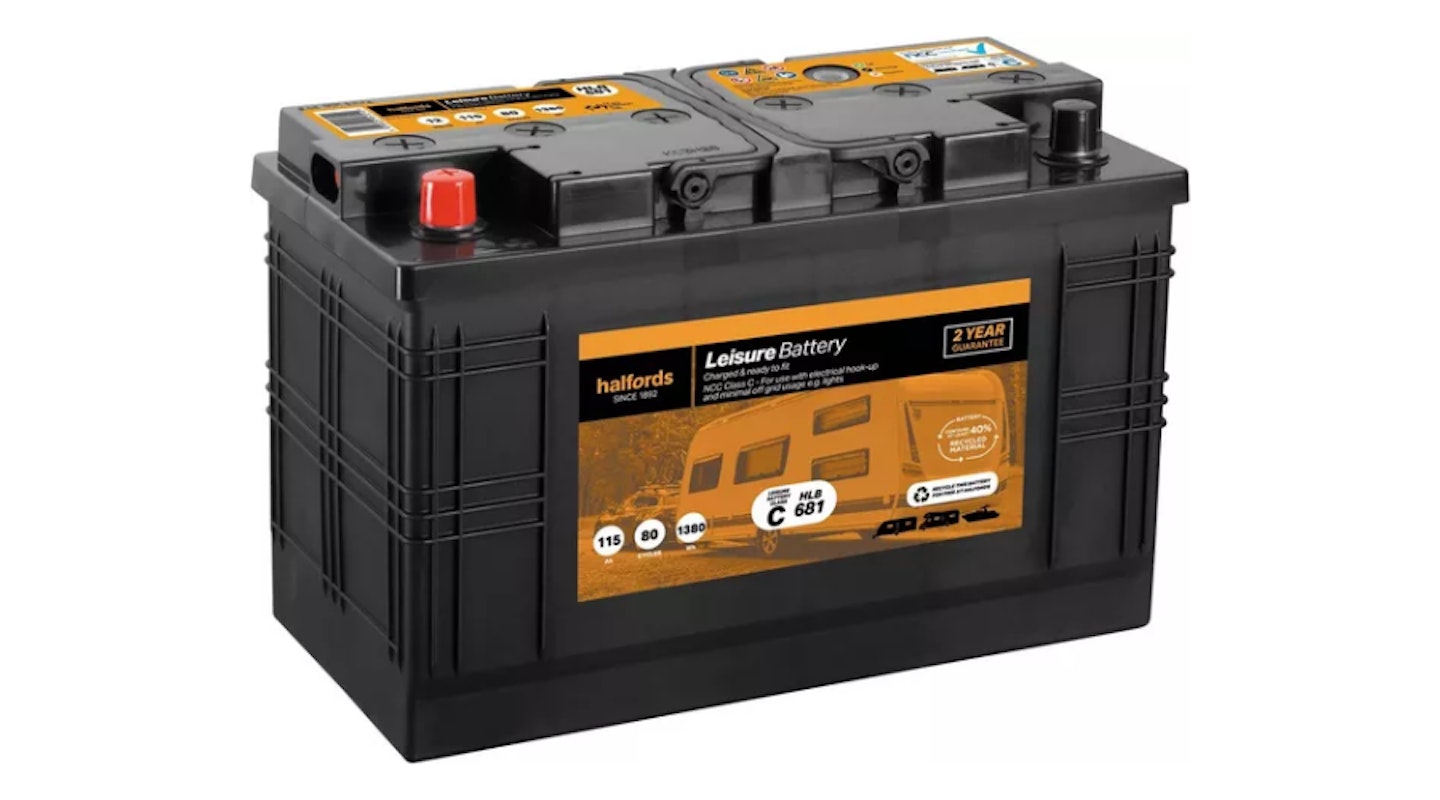 Halfords
Halfords Halfords make it back into this list thanks to the HLB681. As a Class C leisure battery, it delivers 115Ah. We recommend this for use on shorter trips to meet those with essential power needs – you'll always be able to boil the kettle or turn on the lights on your weekend away. It can also be used with an electrical hookup for added flexibility. Once again, you get a manufacturer's guarantee of two years as well.
Pros
- Good capacity for this price
- 2-year warranty
- Optimised for repeated charging & discharging
Cons
- None at this price
| Capacity | 115Ah |
| Dimensions | 350D x 174W x 224H mm |
| Battery technology | EFB |
| Battery Class | C |
| Terminal | Marine |
| Voltage | 12V |
| Weight | 25.4kg |
Best Class A under 100Ah
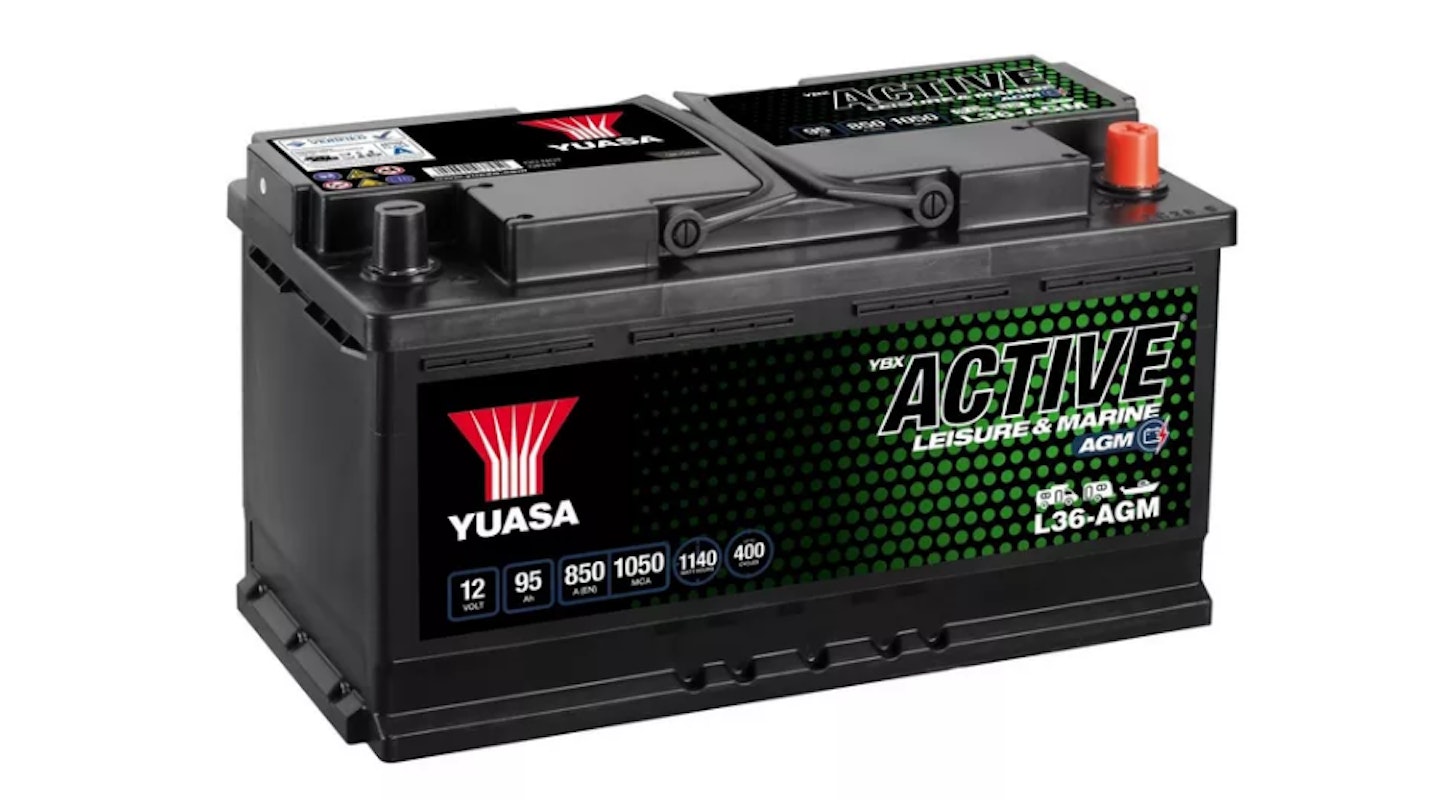 Halfords/Yuasa
Halfords/Yuasa The Yuasa L36-AGM is an AGM battery with 95Ah. Weighing 25.6kg, this is a Class A leisure battery – meaning that it can deliver charge to heavy-duty items and equipment as well as the usual domestic appliances. It is maintenance-free and has a manufacturer's guarantee of two years as well. Despite being a Class A unit, it is designed as a deep-cycle battery – meaning it's supposed to be fully discharged between charges. But that's not a problem with a lower-capacity model like this one. We think that it's absolutely ideal for short to medium-term trips away from a mains hookup.
Pros
- Can power high-energy appliances
- Ideal for off-grid use
- Enhanced safety features
Cons
- If needed, compatible-length battery trays can be hard to find
| Capacity | 95Ah |
| Dimensions | 353D x 175W x 190H mm |
| Battery technology | AGM |
| Battery Class | A |
| Terminal | Marine |
| Voltage | 12V |
| Weight | 25.6kg |
How to choose the best leisure batteries for you: Buyer's guide
What are leisure batteries for?
Leisure batteries are mostly used for motorhomes, caravans, and marine use. They sit at 12v – and only 12v (except for power stations with built-in inverters for mains power). They release their charge in a controlled, smooth flow. Standard leisure batteries are typically used with low-power devices. Depending on their Class rating and capacity, they can be used with kettles and TVs, fans and lights.
As Lifesure notes, the best leisure batteries also can smooth out and correct irregularities in a power supply - that's ideal for anything that needs a supply that's as close to a domestic socket as you can get.
What battery size do you need?
Firstly, it's a great idea to line up your most-used electrical items and find out how much power they'll require. In the winter you might have greater power needs, especially if you're topping up your heating with a portable oil-filled radiator. You'll need to have factored-in seasonal needs like this – and even extras like watching more TV if you're cooped up inside in the warm.
For example, your device voltage (e.g.: a portable TV) might draw 2.5 Amps. Multiply that current by the hours of usage (e.g.: three hours of watching TV) and you have your amp-hours = 7.5 Ah.
With most batteries listing their amp hours high on the specifications, it should be easy to add up all of your requirements and know you'll have enough power (and a bit more to be safe) to meet your needs
Plan for some maintenance
Treat any item that delivers power with some care and attention. Store batteries in a safe and dry location. Also, ensure that the terminals are greased.
Further to this, some batteries need to have their acid levels monitored and topped up with deionised water. Some batteries are maintenance-free – typically those under 14.6V, or lithium technology. If in doubt, check with the manufacturer.
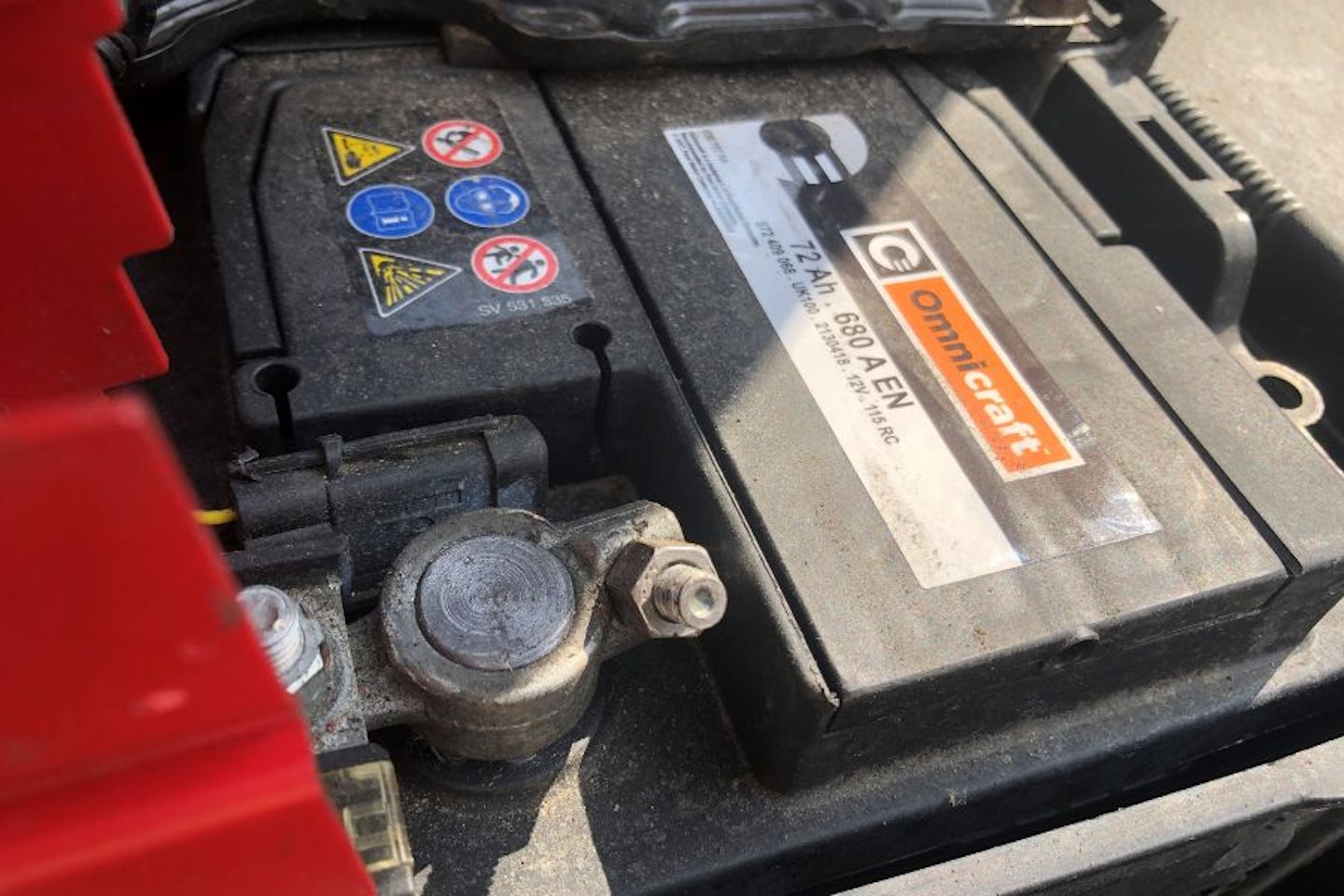
Jargon buster
Types of leisure battery
Lead Acid – Lead Acid is the most common type. They require maintenance and venting. They take damage if left to run flat. Valve Regulated Lead Acid batteries operate in the same way but do not require venting.
Absorbent Glass Mat – Absorbent Glass Mat, or AGM, combines compressed glass fibres with acid. This extends that battery's lifespan. As sealed units, maintenance is of a minimum. They can sit on their ends and sides, just not upside down. Therefore, an AGM charger is required; and these units tend to be more expensive than Deep Cycle batteries.
Enhanced Flooded Batteries – EFB products are an enhanced version of standard lead acid technology. They offer improved charge acceptance and greater durability with charge cycles.
Gel – Like AGMs, Gel batteries are sealed units so can be laid on their side. They are leakproof and can recharge if run flat (though still not advised). Gel batteries are the safest option and are commonly in camper vans and motorhomes from Europe. They are one of the most expensive battery types.
Lithium – Lithium batteries are durable and perform well at extreme temperatures. They're maintenance-free too. They are a modern alternative to other types and sort more energy with less weight. They can also deliver accurate data for power monitoring. They are, however, more expensive.
Battery classes and categories
Regardless of the type of technology a leisure battery has on the inside, they're normally grouped into categories based on their best use case.
Class A – Higher capacity batteries for those who frequently spend extended time away from an electrical hook-up.
Class B – Medium capacity for those who often use mains hook-up but also need to run more power-hungry devices like motor movers or heaters.
Class C – Standard batteries that have enough capacity to cater for typical basic operation of habitation equipment for shorter stays away from mains hook-up.
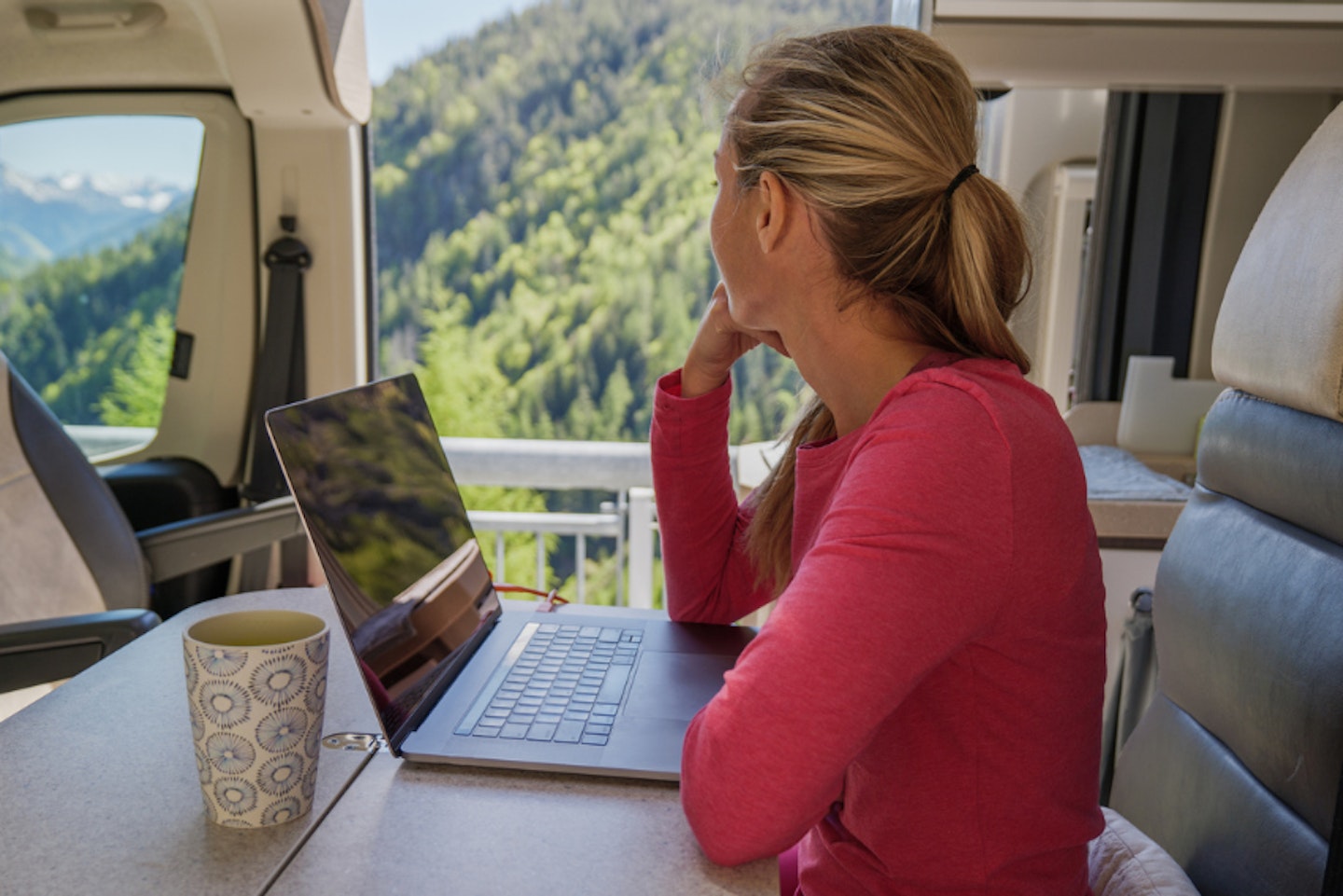
FAQs
How long should a battery last?
As with any battery, the elements of a leisure battery degrade over time and the performance will decrease. We recommend you replace your battery after five years, even if the battery is holding up well.
Can I use a car battery?
No. Although they look alike, a car battery and a leisure battery discharge power differently. A car battery will release its power in one short, sharp jolt before being recharged via an alternator. The best leisure batteries release their power in a slow, controlled stream.
Can I use solar power instead to recharge a leisure battery?
Portable solar power has gained a lot of traction in recent years. However, they're better suited to keeping smaller power stations topped up for powering gadgets like phones and laptops. Plus, with solar, there's no guarantee that you'll have enough sunlight to keep up with heavy usage.
If you do want to have extra capacity with the added benefit of solar recharging, something like the Jackery Explorer 500 portable power station that we reviewed is a great additional battery to take with you. But for powering your caravan, motorhome or marine vehicle, a leisure battery is the best option for reliable power on the go.
Why should you trust us?
At What’s The Best, our mission is to provide accurate and reliable reviews, ensuring our readers receive honest and transparent information about the best technology products available. Anything less would undermine our commitment to being a trusted source of unbiased product information.
Our dedicated in-house writing team comprises experts with extensive experience and a genuine passion for technology. Collectively, we have spent decades testing and writing about tech, leveraging our expertise in all our articles, advice pieces and reviews.
We maintain complete editorial independence and do not accept payment for product reviews. Our writers have full control over their content, ensuring that products are selected based solely on the needs of our readers. While we may earn commissions or other compensation from links on our website, this never affects our product choices. These links enable us to continue offering valuable consumer advice, without compromising the integrity of our reviews.
William Lobley is the Editor for What's The Best. Here, he oversees, curates and researches listicles and reviews as many products as his home office can handle.
He has spent nearly five years writing about tech, audio, outdoors and fitness and has reviewed everything from smartphones to ice baths. In addition, he's well-versed in sniffing out the best deals and savings the internet offers.
When not at his desk writing, reviewing or deal-hunting, he'll be relaxing with Japanese crime novels, bingeing some classic anime, strolling the countryside or at the gym listening to the heaviest metal Spotify has to offer.
Subscribe to the What’s The Best Newsletter to keep up to date with more of the latest reviews and recommendations from the What’s The Best team.
